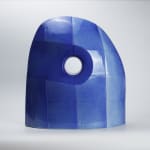Miyanaga Tozan III (Rikichi) 三代宮永東山
H44.5 × W40.6 × D18.4 cm
Further images
-
(View a larger image of thumbnail 1
)

-
(View a larger image of thumbnail 2
)

-
(View a larger image of thumbnail 3
)

-
(View a larger image of thumbnail 4
)

-
(View a larger image of thumbnail 5
)

-
(View a larger image of thumbnail 6
)

-
(View a larger image of thumbnail 7
)

-
(View a larger image of thumbnail 8
)

-
(View a larger image of thumbnail 9
)

-
(View a larger image of thumbnail 10
)

-
(View a larger image of thumbnail 11
)

-
(View a larger image of thumbnail 12
)

-
(View a larger image of thumbnail 13
)

-
(View a larger image of thumbnail 14
)

-
(View a larger image of thumbnail 15
)

A second-generation member of Sōdeisha (the “Crawling Through Mud Association”), Miyanaga Tozan III—whose artist name is Rikichi—is today one of the last living and actively working masters of this influential avant-garde ceramic movement. Founded in Kyoto in 1948, the Sōdeisha movement was pivotal in changing the world of tradition in Japanese ceramics. The organization, formed by Yagi Kazuo Yamada Hikaru and Suzuki Osamu, aimed to break away from the long-standing traditions of Japanese pottery. Rejecting utilitarian function, the group adopted the visual languages of international avant-garde art movements, such as Abstract Expressionism, Geometric Abstraction, and even Surrealism, departing from the functional vessel, and moving towards objet d’art and sculptural forms.
Born into a lineage of Kyoto-based ceramicists, Miyanaga Rikichi was influenced by Sōdeisha’s ideology from a young age. By the late 1950s, he began forging his own distinct and versatile artistic style.
“Harmony in the Sky” is a sculpture that experiments with cobalt blue glaze. The surface of this form is divided into alternating sections of light and dark cobalt blues, each section partitioned with etched striped carvings, emphasizing the distinct variations of blue that emerge across the surface. In the center, a hole has been carved through the work. One might recall an impression of a “Nazar” amulet. The work belongs to the latter half of Miyanaga’s career, reflecting a seasoned understanding of the relationships between form, surface, and glaze in his ceramics. The deep blue serves as a sculptural interpretation of the Sometsuke glaze, resulting in a vessel full of strength and a vibrant, dynamic energy.














